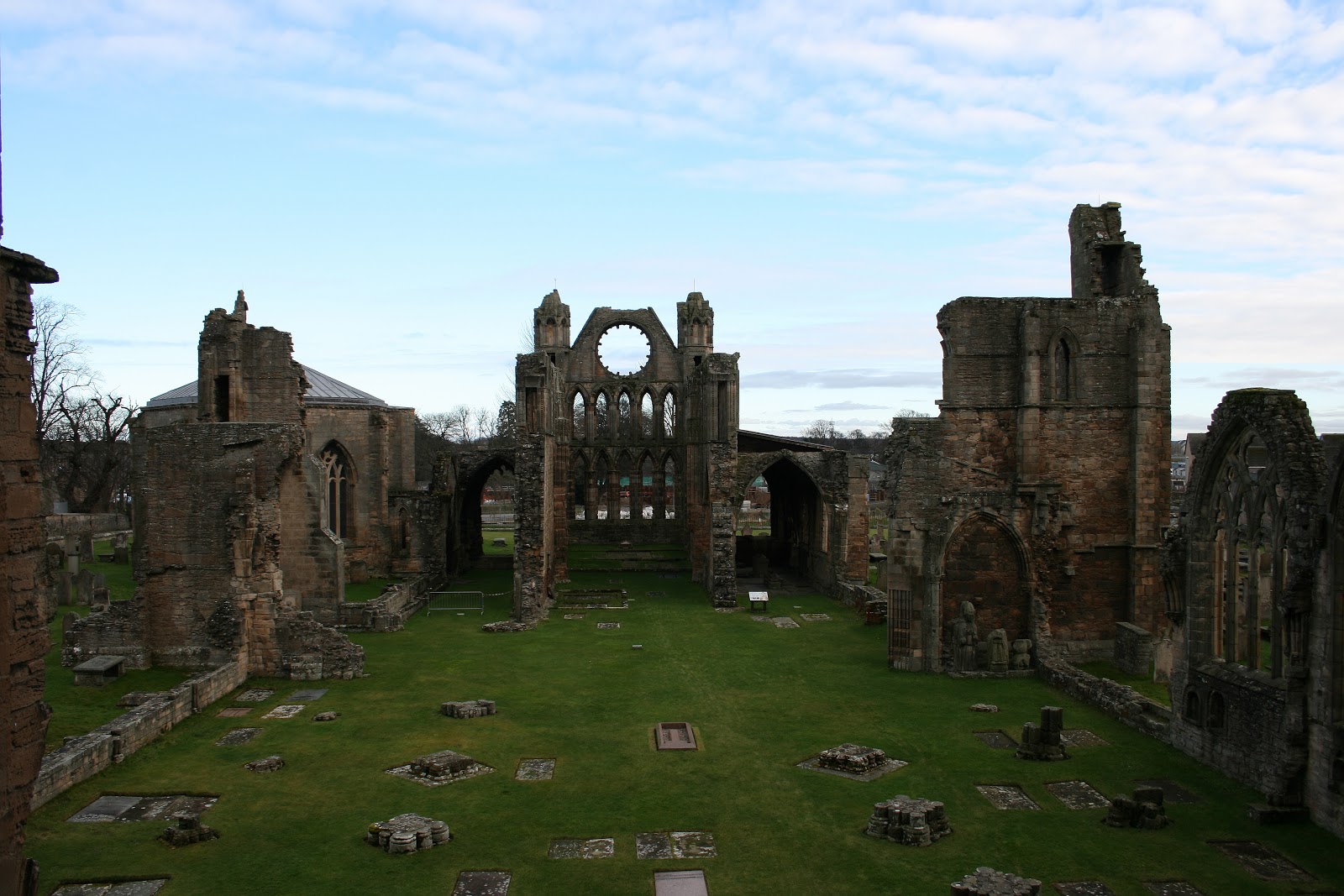Elgin and its cathedral
Our first proper stop was Elgin, with its beautiful Cathedral, or what remained of it. Elgin Cathedral is a 13th-century cathedral and the ruins is all that remain of one of Scotland's architectural triumphs (ref. Eyewitness Travel). The cathedral was once known as The Lantern of the North, but was severely damaged in 1390 by Alexander Stewart, son of King Robert II and known as Wolf of Badenoch, in revenge for his excommunication by the Bishop of Moray. The times in which he lived were barbarous, but even by their standards he stood out, and was feared over a considerable distance.
Effectively redundant from the time of the Reformation in 1560, the sandstone cathedral was little used during the next 100 years
and was virtually abandoned thereafter. Further damage came in 1576 when the Regent Moray ordered the lead roofing to be stripped. Gradually parts of the structure collapsed as a
result of unchecked decay, and it was not until the early 19th century
that Elgin Cathedral received the respect it deserved as a fine piece of
medieval architecture.
Despite the rough treatment, Elgin Cathedral is still beautiful and from the top of the front towers you get a pretty good view of Elgin and its surroundings.Elgin Cathedral was also the place where we became members of Historic Scotland. For just over £80, the whole family gets access to over 70 of Scotland's top heritage attractions, access to special events etc. For us this was a no-brainer, after visiting 3-4 attractions we would have saved the membership cost and at the same time we would be supporting a good cause.
After our visit to the cathedral, we went in to the charming little town. With its cobbled marketplace and crooked lanes, Elgin retains much of its medieval layout and still has a relaxed atmosphere.
Fort George
 After our visit to Elgin, we drove to Fort George, one of the finest examples of European military architecture (ref. Eyewitness travel).
After our visit to Elgin, we drove to Fort George, one of the finest examples of European military architecture (ref. Eyewitness travel). Following the 1746 defeat at Culloden of Bonnie Prince Charlie, George II created the ultimate defence against further Jacobite unrest. When the fortress was completed in 1769, the Highlands were peaceful but it was maintained in readiness for action that never came, and has remained virtually unaltered. Visitors today can see historic barrack rooms which are a time capsule of the domestic life of the Scottish soldier. This is part of The Highlanders’ Museum, which is the largest regimental museum in Scotland, outside of Edinburgh. It covers three floors of Fort George’s former Lieutenant Governors’ House. The museum has roughly 20,000 artifacts and an estimated 10,000 documents and photographs.
 Fort George is the only ancient
monument in
Scotland still functioning as intended (a working army barracks) but
still welcoming visitors. The fort may contain a museum, but it also
keeps updated on the needs of its visitors. We noticed that the old
phone booths have also been upgraded with new functionality.
Fort George is the only ancient
monument in
Scotland still functioning as intended (a working army barracks) but
still welcoming visitors. The fort may contain a museum, but it also
keeps updated on the needs of its visitors. We noticed that the old
phone booths have also been upgraded with new functionality.  The fort is positioned strategically on a peninsula in the Moray Firth ('firth' is what would be known as a 'fjord' in Scandinavia) and was intended as an impregnable army base. As you can see from the picture, it follows the shape of the peninsula and has canons positioned to reach any ships sailing up the Moray Firth. It also has an impressive defense system to stop any attackers on foot.
The fort is positioned strategically on a peninsula in the Moray Firth ('firth' is what would be known as a 'fjord' in Scandinavia) and was intended as an impregnable army base. As you can see from the picture, it follows the shape of the peninsula and has canons positioned to reach any ships sailing up the Moray Firth. It also has an impressive defense system to stop any attackers on foot. The stone used to build Fort George came across the Moray Firth from the Black Isle. The barracks and the garrison chapel are made from beautiful red stone. The stones are of different shades of red and the size of the stones vary quite a lot, creating a very beautiful structure.
The stone used to build Fort George came across the Moray Firth from the Black Isle. The barracks and the garrison chapel are made from beautiful red stone. The stones are of different shades of red and the size of the stones vary quite a lot, creating a very beautiful structure.
It's unclear who designed the garrison chapel, but according to Historic Scotland it was probably the famous Scottish architect Robert Adam, whose family construction company built the fort. The chapel blends in nicely with the style of the other buildings of the fort, standing out only slightly with its square and round towers.
 Once inside the chapel we were very fascinated by the stained glass window behind the altar at the end of the chapel. In addition to the traditional motif of an angel playing the harp, there is an angel playing the bagpipes,see top right-hand window.
Once inside the chapel we were very fascinated by the stained glass window behind the altar at the end of the chapel. In addition to the traditional motif of an angel playing the harp, there is an angel playing the bagpipes,see top right-hand window.
I doubt if you get that anywhere else in the world!



No comments:
Post a Comment